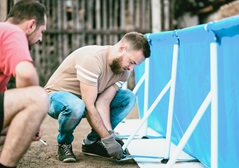Install And Operate AG Pool

How Do I Install and Operate an Above-Ground Pool ?
Above-ground pools are the cost-effective alternative to in-ground pools. They’re also easier to install and maintain. But above-ground pools still require some equipment and maintenance to keep them operational and safe to swim in. Here’s what it takes to make an above-ground pool work.
The Pool Materials
Above-ground pools come in various materials, including aluminum, steel, vinyl, resin, plastic and fiberglass. In addition, they come in various shapes and sizes. Learn about all of your options here.
The Pool Location
An above-ground pool must be installed on level ground. Avoid installing it on concrete, tar paper, asphalt, gravel, peat moss, wood or mulch. Above-ground pools should only be installed on soil.
Before you pick a location for your pool, check the building codes in your area to see if there are any specific regulations on pool placement. Beyond that, you want to consider things like:
- Privacy
- Safety
- Appearance
Also consider where the trees are located in your yard. Trees can keep your pool water cool, but they can also drop leaves, twigs and other debris into your pool.
The Pool Installation
The initial installation must be done well for an above-ground pool to operate without issues. Generally, above-ground pool installations are DIY-friendly, but when in doubt, consider hiring a pool professional to install your above-ground pool.
The Pool’s Walls
An above-ground pool’s walls need almost as much attention as the pool’s water. Don’t let people sit or stand on the pool’s walls because it can cause them to crease, crack and collapse. You’ll also want to keep an eye on the rust under the top rail and replace the rail when it gets too rusty.
Be on the lookout for falling trees, pecking wildlife and nesting insects, all of which can damage an above-ground pool — and be sure to use extreme caution when mowing grass around the pool.
The Filtration System
The pool’s filtration system is what keeps your pool water clean. It consists of two different parts.
- The Pump: Circulates water through your pool’s filter
- The Filter: Captures dirt and debris
You can buy the pump and filter separately, but many above-ground pool owners opt for a combined system, like the Polaris Prestige™ Filtration System.
You will also need a skimmer, which typically hangs from the side of the pool to collect debris from the surface of the water.
Sanitizers and Sanitizer Equipment
Another important part of water care is the sanitizer. Chlorine is the most popular type of pool chemical used to sanitize above-ground pools, and it works to help keep the water free of bacteria and algae.
There are several different types of sanitizer equipment, but the most popular options are:
Primary Sanitizer Equipment:
- Tablet Feeders – use chlorine tablets and either attach to your equipment line
- Erosion Feeders –use chlorine tablets and float around your pool
- Salt Chlorinators – generate chlorine from pure salt that’s added to the pool water through a process of electrolysis that takes place within the cell of the chlorinator (not recommended for steel above-ground pools)
Secondary Sanitizer Equipment
- Ozone Generators – generate ozone through either corona discharge (an electric current is used to create ozone) or ultraviolet light (UV lamps are used to turn air into ozone) to sanitize the water as it passes through the ozonator
- Ultraviolet Sanitizer –water enters an enclosed UV chamber where it is exposed to intense UV rays, which destroys bacteria, algae, parasites, viruses and spores in the water
Mineral Sanitizers
Mineral sanitizers are sometimes used as a secondary sanitizer to reduce chlorine. These sanitizers cannot be used alone, as they do not leave a residual that continues to sanitize the pool water, like a primary sanitizer (chlorine, bromine, etc.) does.
No matter what sanitizer you use, regularly check your pool’s pH and chlorine levels to make sure it’s safe to swim.
Ongoing Maintenance
To keep an above-ground pool in working condition, ongoing maintenance is vital. A proper maintenance plan includes:
- Regular pH and chlorine testing
- Running the pump at least eight hours per day (even if you don’t swim)
- Cleaning out the skimmer and pump baskets
- Cleaning or backwashing your filter
- Vacuuming the pool’s floors and walls with an above-ground pool cleaner
In cold climates, you’ll also need to winterize the pool or take it down once the season is over.
Additional Notes on Operating an Above-Ground Pool
Other things you might need for your above-ground pool include:
- Ladders
- Skimmers
- Automation systems
- A pool cover
- Pool lights and toys
It takes a bit of work and equipment to keep an above-ground pool operational, but the work is worth the reward of quality time with family and friends!



